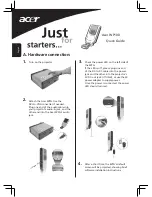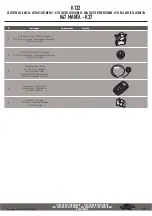
Static Single-Point TEACH Procedure - Push Button
Static TEACH Procedure - Push Button
R55F Series Fiber-Optic Color Mark Sensors
Push Button
Resulting Indicator Status
Press and hold STATIC button
until LO and DO indicators
alternately flash, then release
button.
LO and DO: Alternately flash green
: ON amber (indicating ready to
teach output ON condition)
Light Bar: Goes OFF
TEACH Condition #1
(Output ON state)
Present the output ON sensing
condition and single-click
STATIC button.
LO and DO: Alternately flash Green
: OFF (indicating ready to teach
output OFF condition)
Light Bar: Remains OFF
TEACH Condition #2
(Output OFF state)
Present the output OFF
sensing condition and single-
click STATIC button.
Contrast accepted: one of the ten
segments flashes for three seconds to
indicate relative contrast, and then the
sensor enters RUN mode.
Contrast too low: every other segment
flashes for three seconds to indicate low
contrast, and the sensor returns to TEACH
Condition #1.
SETUP
DO
LO
OFF
Delay
Switch Point
+
DYNAMIC
–
ST
A
TIC
Press and Hold
≥
2 seconds
SETUP
DO
LO
OFF
Delay
Switch Point
+
DYNAMIC
–
ST
A
TIC
Single-click
SETUP
DO
LO
OFF
Delay
Switch Point
+
DYNAMIC
–
ST
A
TIC
Single-click
Signal Strength
Light Bar
Push Button
Resulting Indicator Status
Press and hold STATIC button
until LO and DO indicators
alternately flash, then release
button.
SETUP
DO
LO
OFF
Delay
Switch Point
+
DYNAMIC
–
S
TAT
IC
Press and Hold
≥
2 seconds
LO and DO: Alternately flash green
: ON amber (indicating ready to
teach output ON condition)
Light Bar: Goes OFF
TEACH Condition to be
Sensed (Output ON state)
Present the output ON sensing
condition and double-click
STATIC button.
SETUP
DO
LO
OFF
Delay
Switch Point
+
DYNAMIC
–
ST
A
TIC
Double-click
LO or DO: depending on condition of
taught
: OFF
Light Bar: Two center segments are lit
if TEACH was successful.
NOTES:
1) The sensor will return to RUN mode if either TEACH condition is not registered within 90 seconds. Also,
TEACH mode may be cancelled by pressing and holding the push button for
≥
2 seconds. In either case, the
sensor will revert to the previous conditions taught (i.e., exit without save).
2) If the sensing conditions are accepted at the end of TEACH Condition #2, the signal strength light bar flashes
one of its ten segments for three seconds to indicate relative sensing contrast. The higher the flashing
segment, the higher the measured sensing contrast. High contrast relates directly to sensing reliability. High-
contrast sensing applications are most tolerant of sensing variables, such as web flutter or variations in color
mark color or print density.
See page 8 for Remote
TEACH procedures
Buy: www.ValinOnline.com | Phone 844-385-3099 | Email: [email protected]






























